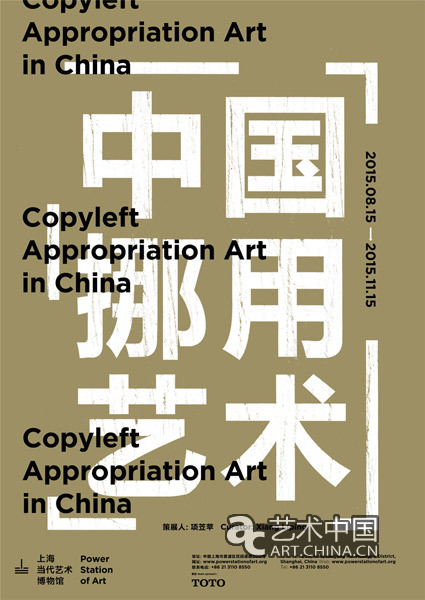
開幕時間:2015年8月14日(週五) 17:30
展覽時間:2015年8月15日-2015年11月15日
展覽場館:上海當代藝術博物館5樓
展覽館址:上海市花園港路200號
Vernissage:17:00, 7th August, 2015
Venue:5F, Power Station of Art
Address:200, Huayuangang Rd. HuangpuDistrict, Shanghai,China
各板塊藝術家名單如下
1.和中國藝術傳統相關的臨摹現象:夏小萬、邱志傑、姚瑞中、陳浚豪、彭薇、余旭鴻、楊泳梁、倪有魚
2.和西方現當代藝術相關的挪用現象隋建國、李佔洋、施勇、楊振中、李青、倪有魚、胡慶泰、胡昀、王冠山
3.和當下社會現象相關的山寨現象陳幼堅、韓峰、周鐵海、邱志傑、焦興濤、李青、高巖、鐘兆剛、葉甫納
開幕當日活動 Vernissage Program
15:30 - 16:00 媒體簽到 Press Registration 丨5F
16:00 - 16:30 媒體導覽 Guided Tour 丨5F
16:45 - 17:15 新聞發佈會 Press Conference丨3F
17:30 - 19:30 開幕儀式 Vernissage 丨5F
當下社會,山寨現象風生水起,抄襲事件層出不窮。回望中國當代藝術的起點,認為中國當代藝術以西方馬首是瞻的指控不絕於耳。盤點中國古代藝術發展歷程,一味摹倣前人、陳陳相因更是晚清以來文人畫的常用標簽。中國人果真如西方人所指責的是一貫不尊重版權和不懂創新的嗎?中國當下的山寨現象、藝術創作中的抄襲和我們行之已久的臨摹傳統有關嗎?西方人可以絲毫不差的“挪用”,為何中國人不能進行有所改變的“山寨”?複製和複製品的氾濫會影響藝術的創新發展嗎?
基於以上想法,通過梳理中國當代藝術中和挪用相關的藝術創作現象,本次展覽首次提出了“中國挪用藝術”的概念,對源自西方的“挪用藝術”理論進行了拓展和轉換,將“挪用”與中國自古以來的藝術傳統“臨摹”和當下風生水起的“山寨”現象結合起來,打造了一個連結中西古今的“中國挪用藝術”概念。
中國挪用藝術至少包含三種現象:和中國藝術傳統相關的臨摹、和西方現當代藝術相關的挪用以及和當下社會現象相關的山寨。通過梳理中國當代藝術中和臨摹、挪用、山寨相關的藝術創作現象,探討重復和創新、原創的關係,藝術創作方式和新技術、新材料的關係,智慧財産權和知識共用、知識傳承的關係,從中也可以看出中國挪用藝術和西方的不同之處。
“Copyleft”出自GNU通用公共許可協議(GNU General Public License,縮寫:GNU GPL、GPL),這是一個被廣泛使用的自由軟體許可協議條款,給予了電腦程式自由軟體的定義,並且使用“Copyleft”來確保程式的自由能被完善的保留。
此處借用“Copyleft”來表現中國挪用藝術中臨摹、挪用、山寨三種現象的共通之處,意味著 “可以拷貝”(和copyright相左),以及“製造拷貝“(製造相似之物)。copy和copulation(交配)有著相同的拉丁文詞根“copia”,意味著由此而來的繁衍創新,難怪磯崎新聲稱,拷貝的拷貝的拷貝就是創新。在數位複製時代,不只藝術家精於“挪用”,其實絕大多數人和“Copyleft”、“挪用”脫不了干系——對網路圖文資料的複製黏貼使用,對盜版碟或仿製品的購買,對著手機私人定制的電影配音,在卡拉OK廳裏對歌星或好或壞的模倣,各類模倣秀上選手始於模倣終於創新的表現……“個別的模倣是跟隨,普遍的模倣孕育著創新。”新技術的發展和普及釋放了廣大民眾的創造力,進一步打破了藝術和生活的界限,也許是時候用更中性甚至欣賞的眼光去打量“山寨”了。
In today’s society, the shanzhai phenomenon grows at an incredible pace, with instances of plagiarism occurring in endless succession.Looking back to the beginning of China’s contemporary art, one finds the lingering accusation that it followed the lead of Western countries. Yet, in the course of development for Chinese historical art, imitating the work of predecessors, and following a path of incremental change, was a regular practice especially dating back to the literati painting of the late Qing dynasty. Are the Chinese really, as Westerners have suggested, consistently failing to respect copyright, or lacking in an understanding of innovation? Is there a relationship between China’s current shanzhai phenomenon, appropriation in the artistic process, and our long-established linmo tradition of imitating earlier works? If Westerners can “appropriate” without adding even minor variation, why can’t the Chinese produce “shanzhai” versions with some form of alteration? Will the flood of duplications and replications affect the innovative development of art?
Through an overview of contemporary Chinese art and specifically art production related to copying, this exhibition proposes for the first time an evaluation of Chinese appropriation art that expands and transforms Western appropriation art theory.
Chinese appropriation art contains at least three forms: linmo that draws on China’s art tradition, appropriation related to Western contemporary art, and art production inspired by the current phenomenon of shanzhai. From a survey of art that uses these methods, the exhibition investigates the relationships between: replication, innovation, and originality; new technologies, new materials, and artistic creation; and intellectual property laws, knowledge sharing, and forwarding generational knowledge.
Copyleft is appropriated from the GNU General Public License, which is the most widely used free software licensing agreement. Here, Copyleft is used to represent three manifestations of copying (linmo, appropriation, and shanzhai) that occupy a common ground.
In this age of digital reproduction, indeed most people can’t escape the implications of Copyleft and appropriation: they are in the copying and pasting of found materials from the Internet, in pirated DVDs...."Individual copying is to follow; wide spread copying gives birth to innovation." The development and popularization of new technologies liberates the creativity of the general public, possibly it is time to use a more neutral or even appreciative gaze in sizing up "shanzhai."